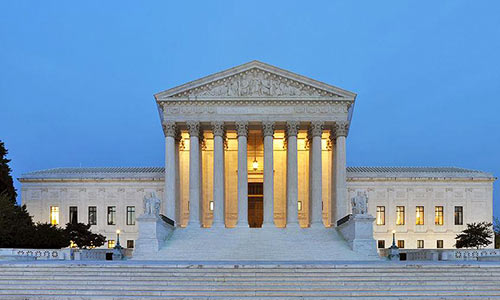INTERNATIONAL 09/06/2023
Supreme Court Rejects GOP-Drawn Map That Limited Black Districts

The US Supreme Court gave an unexpected boost to the Voting Rights Act, rejecting a Republican-drawn congressional map in Alabama and upholding a decision that requires a second majority Black district.
The 5-4 ruling marks a major turn for a court that twice in the last decade has significantly cut back the landmark law, enacted in 1965 to protect minority rights at the polls. Chief Justice John Roberts and Justice Brett Kavanaugh joined the three liberal justices in the majority.
Democrats and civil rights activists said the Voting Rights Act’s Section 2 requires a second heavily Black district in a state with seven US congressional seats and a 27% Black population. Alabama’s Republican leaders said the law doesn’t require racial proportionality and gives lawmakers broad leeway to craft districts using racially neutral criteria.
Writing for the court, Roberts said Alabama’s approach couldn’t be squared with a 1986 Supreme Court precedent that sets out the test for redistricting lawsuits under the Voting Rights Act.
The Alabama case “is not about the law as it exists,” Roberts wrote. “It is about Alabama’s attempt to remake our Section 2 jurisprudence anew.”
Read More: Racial Gerrymandering Meets Voting Rights in Supreme Court Clash
Given the state’s voting patterns, a second heavily Black district almost certainly will give Alabama a second Democratic representative. The state now has six Republicans and one Democrat in the House.
The decision could affect pending litigation over congressional maps in Texas, Louisiana and Georgia, as well as similar fights over state and local voting districts.
The Supreme Court put the lower court ruling on hold last year on a 5-4 vote, ensuring the Republican-drawn map would be used for the 2022 election. Kavanaugh was in the majority then, saying that it was too close to election to require a new map and that he wasn’t making a decision on the merits.
In Thursday’s ruling, Kavanaugh said Alabama was effectively seeking to overturn the 1986 ruling, known as Thornburg v. Gingles.
“Unlike with constitutional precedents, Congress and the president may enact new legislation to alter statutory precedents such as Gingles,” Kavanaugh wrote. “In the past 37 years, however, Congress and the president have not disturbed Gingles, even as they have made other changes to the Voting Rights Act.
Justices Clarence Thomas, Samuel Alito, Amy Coney Barrett and Neil Gorsuch dissented. Thomas said the Voting Rights Act doesn’t require states to let Black voters control a proportional number of legislative seats.
“The majority holds, in substance, that race belongs in virtually every redistricting,” Thomas wrote.
Section 2 outlaws election rules that discriminate on the basis of race. The Supreme Court has said in the past the law bars states from drawing voting lines in a way that dilutes the power of racial minorities.
Two sets of challengers said the GOP-drawn maps dilute minority strength in part by dispersing voters in the so-called Black Belt, a largely rural area originally named for the color of its fertile soil. A three-judge panel that included two Donald Trump appointees agreed, saying the map probably violated the Voting Rights Act.
Civil rights groups and the Biden administration hailed the ruling.
“This decision is a crucial win against the continued onslaught of attacks on voting rights,” said Deuel Ross, a lawyer with the NAACP Legal Defense & Educational Fund. Ross argued the case in October on behalf of one group of voters.
“Today’s decision rejects efforts to further erode fundamental voting rights protections, and preserves the principle that in the United States, all eligible voters must be able to exercise their constitutional right to vote free from discrimination based on their race,” Attorney General Merrick Garland said in a statement.
Doug Jones, a Democrat and former US Senator from Alabama called the ruling “an incredibly important decision not just for Alabama, but throughout the South where the minority population is growing maybe more than anywhere else in the country.”
Alabama Attorney General Steve Marshall said through a spokesperson that “although the majority’s decision is disappointing, this case is not over.” As a formal matter, the high court case stemmed from a preliminary injunction, not a final judgment.
“The state is still entitled to put on our full case at trial, and we are confident that the evidence will make clear that voters in Alabama, regardless of their race, have the same opportunity as any other members of the electorate to participate in the state’s political processes and elect representatives of their choice,” Marshall said.
Still, Roberts’ opinion suggested it was a definitive ruling on HB1, as the state-drawn map was known. He said the three-judge panel “faithfully applied our precedents and correctly determined that, under existing law, HB1 violated Section 2.”
In a key part of the opinion, Roberts said the alternative maps offered by the suing voters were “reasonably configured” even though they split the Gulf Coast region in the southwestern part of the state. He rejected Alabama’s contention that the region was a “community of interest” that had to be kept together.
And even if it was a community of interest, “the district court found that plaintiffs’ maps would still be reasonably configured because they joined together a different community of interest called the Black Belt,” Roberts wrote.
The ruling “shows that there is life, power and teeth in Section 2,” said William Roberts, acting senior vice president at the progressive Center for American Progress. “It’s a good day for voting rights and the protection of the Voting Rights Act and for the vindication of Black voters in Alabama and beyond: to know that the law can still protect the rights of voters, given what we’ve faced the last 10 years.”
The case is Allen v. Milligan, 21-1086.



